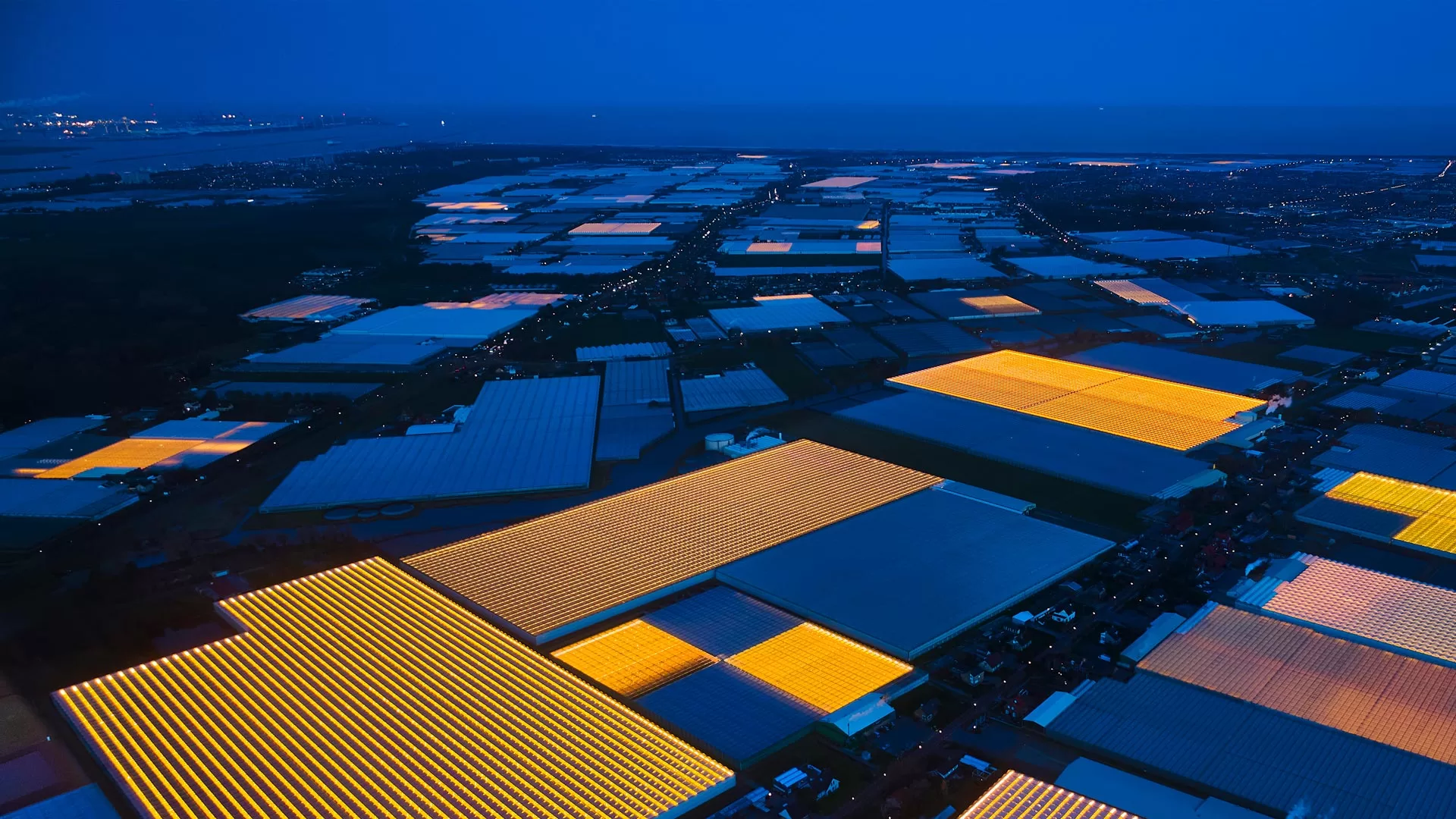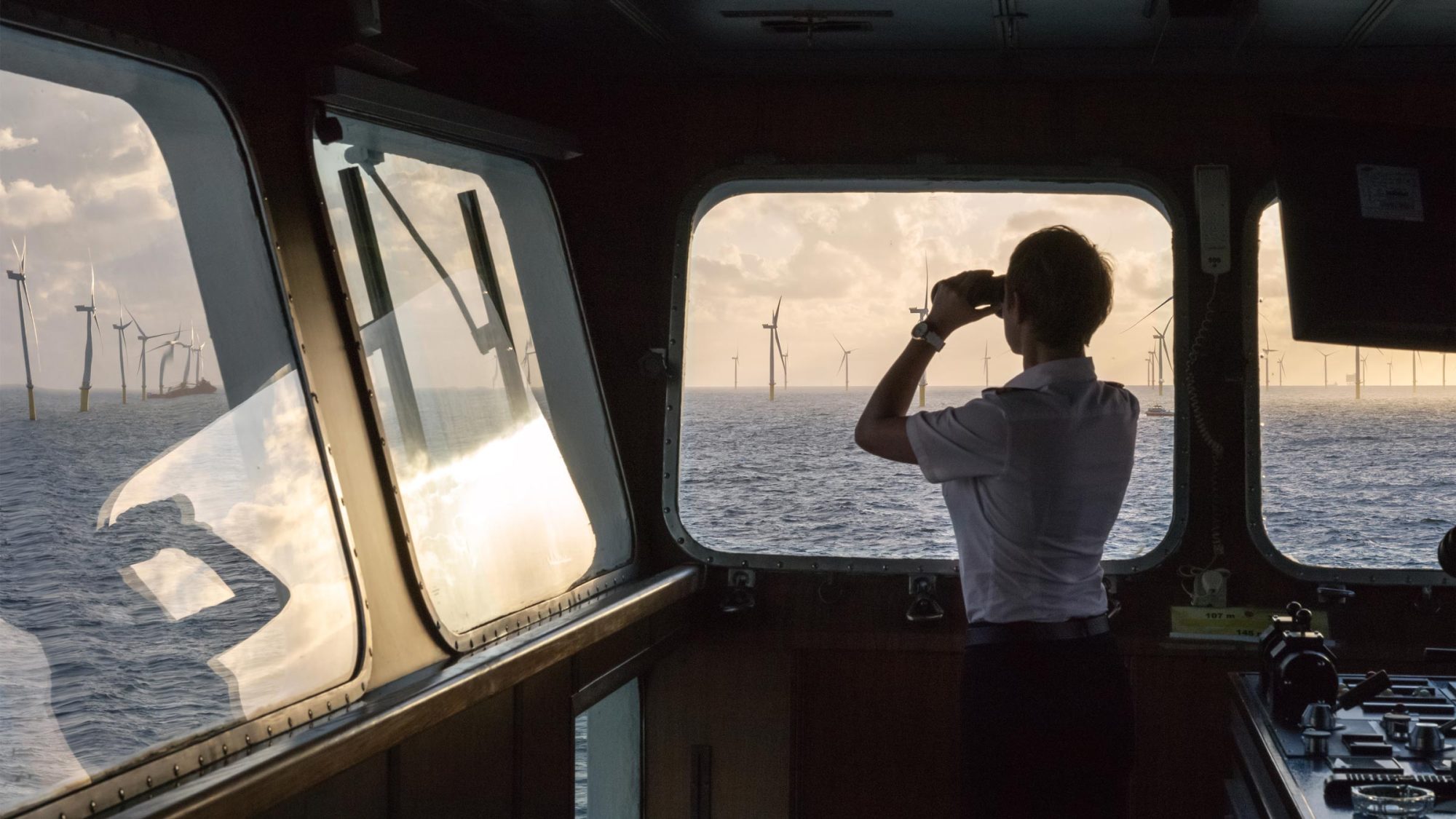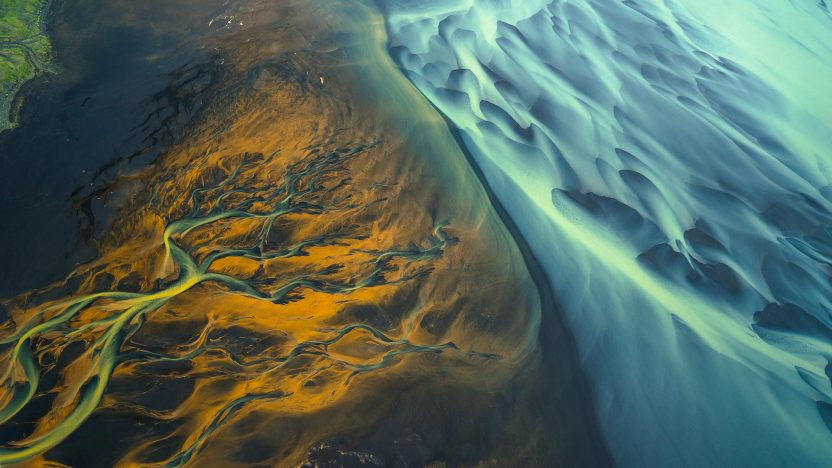
The end of the world makes headlines
Over the last decade, climate change has become more and more present in newspapers and magazines. Here’s what’s changed.
in conversation with Emily Atkin by Alice Azzolini
Photo by Luca Locatelli — Ultra Farming Westland landscape blue light #1, The Netherlands, 2017. Flying over the Westland in the Netherlands, the most advanced area in the world for agro farming technology. Furrows of artificial light lend an otherworldly aura to the greenhouse. Climate-controlled farms such as these grow crops around the clock and in every kind of weather.
Until a short time ago, it seemed impossible to have a serious, public debate on climate change. Scientists had been collecting data and writing alarming reports, but the oil and gas companies systematically covered them up, as most journalists were busy with concerns that seemed more urgent and appealing to the mainstream. But something’s been quietly happening: according to the Peoples’ Climate Vote, a report published in January of this year by the United Nations Development Programme (UNDP), 64% of the 1,2 billion respondents said they consider climate change an emergency.
These figures were unthinkable until just recently. So what has changed? Sure, in recent years, from the fires in California and Australia to the pandemic, climate change has sped up, becoming more tangible for Western countries. But that’s not the only reason. The most remarkable change we’ve seen unfold in the past few years is on the communications front. Whereas before, both the public and the media seemed to view climate change as the elephant in the room, now more and more people are treating the topic for what it really is – an emergency that is already affecting our daily lives in very tangible ways.
For some, the change has affected their words and their acts: In late 2019, The Guardian published its first climate pledge, which addressed how the British newspaper covers the topic (“We will use language that recognises the severity of the crisis we’re in”) and even their business model (“We will no longer accept advertising from fossil fuel extractive companies”). From Forbes to the New York Times, many others inaugurated sections or newsletters dedicated to the subject. Meanwhile, new, independent, non-traditional media outlets began to join the conversation: from the independent magazine It’s freezing in LA, to the podcast Mothers of Invention, journalists and audiences alike are showing how much they need new spaces to talk about climate change, with a new language and a new approach.
We discussed it with Emily Atkin, journalist and founder of the newsletter HEATED, one of the most successful climate media projects of these years, which she created for “people who are pissed off about the climate crisis.” Atkin’s goal is “to expose and explain the forces behind past and present inaction on the most existential threat of our time” with one basic belief: accountability journalism.

Photo by Luca Locatelli — Homo Deus, The Netherlands, 2016. Inside this jungle of tomato plants illuminated by LED lighting, Dr. Henk inspects the crops at a research and development horticulture centre in the Netherlands where academia and the private sector join together for experimental research.
Alice Azzolini: Could you outline the trajectory of environmental journalism since public opinion “discovered” the climate emergency?
Emily Atkin: Climate journalism has undergone a huge cultural shift in how it’s covered in the last 8 years, which is as long as I can really speak of it, because that’s as long as I’ve been doing it. The industry overall has started to change how we think about climate change. When I started, most editors — and even journalists — considered climate change a really tough story to tell. It was approached as a big existential problem that was very hard to fit into the traditional journalistic narrative of a really present battle. And that was partly because it was too controversial to talk about the impacts that were happening in the present, especially in the United States. If you did, you were called an alarmist.
That’s why editors and journalists approached climate change as a really wonky science story. They weren’t really looking at it as what it is: a story about money, influence, and political power. The same way that it took us long to call out Donald Trump for lying, it took us even longer to say, “climate change is real, and the people who say it’s not are lying on behalf of fossil fuel companies.” But once we journalists became more conscious of our problems with the truth, we realized that we were not telling the truth about climate change. We also used to be really obsessed with not scaring people. But we realized that it’s not our job to mold public opinion: our job is to tell the truth. And the truth is that climate change is scary.
Covid-19 has accelerated this trend: since March 2020, we have become obsessed with — and accustomed to — bad news, monitoring the number of infections and deaths every day. Perhaps in the future we could get as obsessed with the average carbon dioxide content of our atmosphere. Somehow, Covid reporting has taught us that if we give relevant information to people, they will respond to it. There’s going to be a positive reaction, even to bad news.
Especially in the US, Covid-19 and the Trump era combined helped move some of the more conservative journalists to cover climate change more aggressively. At the beginning of the pandemic, Trump and the Republican Party denied that Covid-19 was a problem because they knew that it would harm people’s perception of them if they recognized it as such. But we soon realized that they were lying on a scientific issue.
There’s a clear parallel to climate change there. Before Trump, many journalists were obsessed with seeming fair and balanced. Both Trump and Covid-19 made a lot of them realize that sometimes there is a very clear right and wrong, there are facts and not facts — and it’s actually an abdication of your journalistic duty to not call out a lie when the lie is clear.
I started HEATED to remind people what the purpose of journalism is: it’s not to tell both sides and be balanced — that’s not what they teach you in journalism class. The job of the journalist is to speak truth to power. To hold the power to account. It’s to lift up the voices of the vulnerable. To give a voice to the voiceless. So how in the world is reporting on both sides of climate change being responsible journalists?
For most of the time that we’ve known about climate change, journalism has basically just been PR for the fossil fuel industry because it hasn’t taken the threat seriously — and that’s exactly what the fossil fuel industry wants. That’s exactly why they poured in millions of dollars to just downplay the severity of it. And journalists played into that for a long time: they didn’t want people to freak out, so they didn’t tell the truth about climate change, and placated the public. And we’re still dealing with the consequences of that because we still have a completely placated public. If the entire public was as alarmed about climate change as most climate scientists are, then we would have done something drastic to switch to a clean energy economy a long time ago. We wouldn’t be in the position that we’re in now.
And now that we’re stopping being “the PR of the fossil fuel industry,” the fossil fuel industry is striking back. The fight against climate change, even outside of the journalism industry, is becoming a communication fight.
I consider PR & Communication to be the most important side of this battle. What oil companies have to have acknowledged in their own internal documents that journalists have uncovered is that the key to preventing the transition away from fossil fuels is maintaining what’s called a “social license to operate.” They recognize that the key to continuing the fossil fuel economy is making people still like fossil fuels. So they need to make sure people don’t hate them. As soon as public opinion turns against them, we’re going to transition to a renewable energy economy pretty quickly because we have the technology to do it. There’s this myth that we need so much more technology to stop being reliant on fossil fuels. And it’s not true. We need a little bit more, but we can start this process right now. It’s going to be pretty easy once we get the public’s will.
Climate change is 100% a problem of public opinion and political will. So when you start to see an oil company commercial on every single television station, you look at when you see sponsored content from oil companies, every single time you open Twitter, when you go to the airport, and there are oil company ads all over the side, and once you get on the plane, the oil that the airplane company, right before they give you the safety message, tells you about how they’re totally becoming a climate-friendly airline… That’s how you know that this is the number one impediment to climate action. That’s how you know public opinion is the most important thing.

Photo by Luca Locatelli — Volcanic greenhouse Geothermal power, Iceland, 2019. Nestled in the lava fields of the Reykjanes Peninsula, this 2,000 mq greenhouse is using Icelandic water enriched with nutrients, and energy from a neighbouring geothermal power plant.
Feminist and queer communities are more than anyone else leading this fight and actively working to change opinion on climate
Over the summer, I contributed to an anthology of essays and poems by women climate leaders called All We Can Save: Truth, Courage, and Solutions for the Climate Crisis. In the foreword, Ayana Elizabeth Johnson and Catherine Wilkinson, the editors who compiled the book, talk about what it means to be a climate feminist: seeking a solution to climate change that not only stops climate change from happening but that creates a more egalitarian society for all people.
I like thinking of it that way, as a more feminine version of saving the planet, as opposed not to regular masculinity but to toxic masculinity. The masculinity we’ve been taught is extractive: “I will dominate this planet, I will extract its resources, I will drill it with my very phallic drill, I will bend it to my power…” That’s not just how we’ve thought about the world that brought us to a climate crisis, obviously, it’s how a lot of men think when they think about how we are going to solve the climate crisis: “we’re going to go to space, we’re going to have everyone live in space. And we’re going to take the power of the sun, and we’re going to zap it to power the new planet,” and so on. Why don’t we just take better care of the Earth and live in reciprocity with it instead of trying to bend it to submission to our big manly muscles? Science says that we should simply be less extractive, and we’d solve it.
What you’re saying resonates a lot with feminist works from the ‘80s and ‘90s, which are now being taken as landmarks by new generations of climate feminists: from Ecofeminism by Maria Mies and Shiva Vandana to Silvia Federici’s Caliban and the Witch, where the control of women’s bodies is seen as a form of capitalist accumulation.
The most valuable part of these parallels is that this is what happens when you bring the philosophy of “money will solve it.” Money is the key because large profit is inherently extractive, and those that are motivated by it will justify awful behavior — like witch-hunting — to ensure that it isn’t threatened. That’s not just about the fossil fuel industry, but the fossil fuel industry is a really wonderful example of it. Profit also has a bit of a brainwashing effect on the public: you sort of admire those people who are really profitable and want to defend them, because you admire them, you want to be as rich and powerful as they are. Plus, fossil fuels do actually power a lot of our stuff. They sort of Stockholm-syndrome us: we know that they harm us, but we think we need them.
Let’s talk about your newsletter, HEATED. In 2019, you left New Republic to create this solo project, which has been very successful. Do you think HEATED could exist within a traditional media outlet?
Since I started HEATED, I have gotten more mainstream attention than I ever had before, simply because HEATED aggressively pursues the accountability philosophy of climate journalism. I wasn’t the first person to do it, but I was relatively well-known in the community of climate journalists, and HEATED showed people that this can work, especially once it started being profitable. What my project has shown, if anything, is that if a mainstream model wants to succeed, it needs to have this approach.
The extractive masculinity we’ve been taught is extractive is not just how we’ve thought about the world that brought us to a climate crisis. Obviously, it’s how a lot of men think when they think about how we are going to solve the climate crisis.
This kind of thing could definitely happen within an institution. But new institutions have to be created. The trend that we’re seeing of journalists going independent is going to keep happening, and then everyone is going to realize like I have realized over the last two years now, that it’s very hard to run a media organization on your own — even if it’s just a newsletter. So we’re going to see independent journalists start to team up and form their own news outlets. And those news outlets will have a different standard than the ones that we have today: they won’t be as extractive, because that’s why we left. I’m looking forward to that.

Photo by Luca Locatelli — Energiewende, Regina Baltica, Germany, 2015. Regina Baltica vice captain overlooking a wind farm in the North Sea, Germany. Regina Baltica serves as a floating hotel for offshore windfarm technicians.
What’s your relationship with your subscribers? What are the differences with the audience that you reached before HEATED?
My community is an educational resource for me: a lot of them have expertise that I don’t have; they are interested in climate change because they have a degree, job, or experience that makes them have expertise that I don’t. Yesterday I did a thread with my paying community about Jeff Bezos going to space from a climate perspective, and I was thinking about pitching something to MSNBC about it. Some people gave me really great counterpoints. So now, if I do write anything about the topic, it’s my subscribers’ insights that will have informed it. And then, when I’ll put it out to the newsletter, the people that participated in it will feel like they helped. This isn’t a one-way street: this is just me talking to you, you’re talking to me back, and you are helping create a climate media. That is really beautiful, and it’s one of my favorite things about doing the newsletter.
That’s something that I think will be a crucial part of the newsrooms of the future, who have to learn the same lessons that we’re learning about climate change and extraction and live in reciprocity with each other. We have to go back to the fundamentals of this profession, just like we have to go back to the fundamentals of our relationship with the planet. Unfortunately, we went too far into an extraction mindset in journalism: we took everything we could from young journalists, underpaying them and depriving them of real access to the communities they were serving.
Another thing that we have to think about is: how do you become a member of a community? Is it just showing up, or is it paying? Is it if you’ve read a certain number of articles a month? I think there is a barrier to entry before your voice can really start to be heard because there’s too much noise out there for journalists. People who care will show you they care. And we have to figure out the different ways we can have readers show that they care and become members of this community and all work together.



